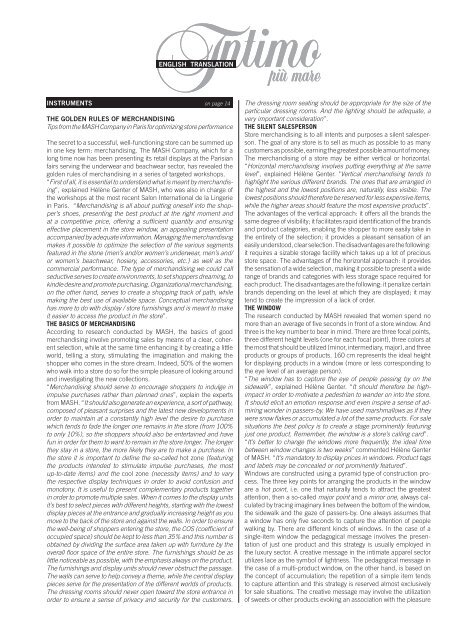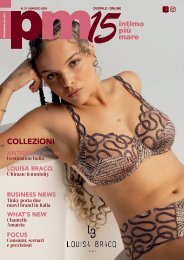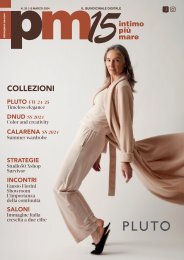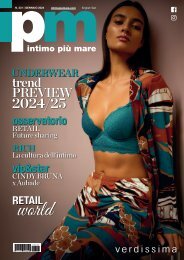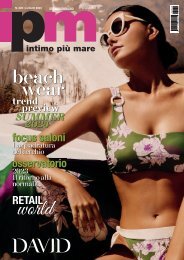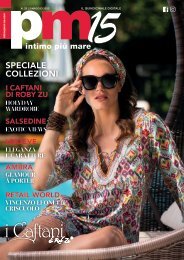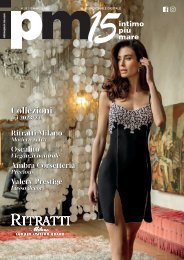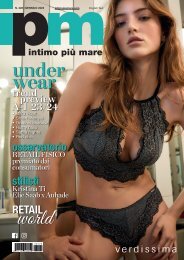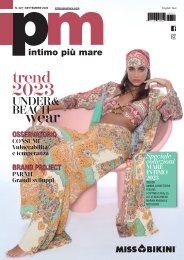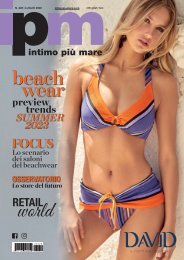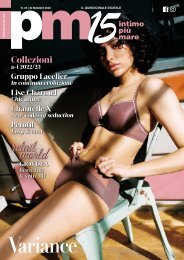You also want an ePaper? Increase the reach of your titles
YUMPU automatically turns print PDFs into web optimized ePapers that Google loves.
ENGLISH TRANSLATION<br />
INSTRUMENTS on page 14<br />
THE GOLDEN RULES OF MERCHANDISING<br />
Tips from the MASH Company in Paris for optimizing store performance<br />
The secret to a successful, well-functioning store can be summed up<br />
in one key term: merchandising. The MASH Company, which for a<br />
long time now has been presenting its retail displays at the Parisian<br />
fairs serving the underwear and beachwear sector, has revealed the<br />
golden rules of merchandising in a series of targeted workshops.<br />
“First of all, it is essential to understand what is meant by merchandising”,<br />
explained Hélène Genter of MASH, who was also in charge of<br />
the workshops at the most recent Salon International de la Lingerie<br />
in Paris. “Merchandising is all about putting oneself into the shopper’s<br />
shoes, presenting the best product at the right moment and<br />
at a competitive price, offering a sufficient quantity and ensuring<br />
effective placement in the store window, an appealing presentation<br />
accompanied by adequate information. Managing the merchandising<br />
makes it possible to optimize the selection of the various segments<br />
featured in the stone (men’s and/or women’s underwear, men’s and/<br />
or women’s beachwear, hosiery, accessories, etc.) as well as the<br />
commercial performance. The type of merchandising we could call<br />
seductive serves to create environments, to set shoppers dreaming, to<br />
kindle desire and promote purchasing. Organizational merchandising,<br />
on the other hand, serves to create a shopping track of path, while<br />
making the best use of available space. Conceptual merchandising<br />
has more to do with display / store furnishings and is meant to make<br />
it easier to access the product in the store”.<br />
THE BASICS OF MERCHANDISING<br />
According to research conducted by MASH, the basics of good<br />
merchandising involve promoting sales by means of a clear, coherent<br />
selection, while at the same time enhancing it by creating a little<br />
world, telling a story, stimulating the imagination and making the<br />
shopper who comes in the store dream. Indeed, 50% of the women<br />
who walk into a store do so for the simple pleasure of looking around<br />
and investigating the new collections.<br />
“Merchandising should serve to encourage shoppers to indulge in<br />
impulse purchases rather than planned ones”, explain the experts<br />
from MASH. “It should also generate an experience, a sort of pathway,<br />
composed of pleasant surprises and the latest new developments in<br />
order to maintain at a constantly high level the desire to purchase<br />
which tends to fade the longer one remains in the store (from 100%<br />
to only 10%), so the shoppers should also be entertained and have<br />
fun in order for them to want to remain in the store longer. The longer<br />
they stay in a store, the more likely they are to make a purchase. In<br />
the store it is important to define the so-called hot zone (featuring<br />
the products intended to stimulate impulse purchases, the most<br />
up-to-date items) and the cool zone (necessity items) and to vary<br />
the respective display techniques in order to avoid confusion and<br />
monotony. It is useful to present complementary products together<br />
in order to promote multiple sales. When it comes to the display units<br />
it’s best to select pieces with different heights, starting with the lowest<br />
display pieces at the entrance and gradually increasing height as you<br />
move to the back of the store and against the walls. In order to ensure<br />
the well-being of shoppers entering the store, the COS (coefficient of<br />
occupied space) should be kept to less than 35% and this number is<br />
obtained by dividing the surface area taken up with furniture by the<br />
overall floor space of the entire store. The furnishings should be as<br />
little noticeable as possible, with the emphasis always on the product.<br />
The furnishings and display units should never obstruct the passage.<br />
The walls can serve to help convey a theme, while the central display<br />
pieces serve for the presentation of the different worlds of products.<br />
The dressing rooms should never open toward the store entrance in<br />
order to ensure a sense of privacy and security for the customers.<br />
The dressing room seating should be appropriate for the size of the<br />
particular dressing rooms. And the lighting should be adequate, a<br />
very important consideration”.<br />
THE SILENT SALESPERSON<br />
Store merchandising is to all intents and purposes a silent salesperson.<br />
The goal of any store is to sell as much as possible to as many<br />
customers as possible, earning the greatest possible amount of money.<br />
The merchandising of a store may be either vertical or horizontal.<br />
“Horizontal merchandising involves putting everything at the same<br />
level”, explained Hélène Genter. "Vertical merchandising tends to<br />
highlight the various different brands. The ones that are arranged in<br />
the highest and the lowest positions are, naturally, less visible. The<br />
lowest positions should therefore be reserved for less expensive items,<br />
while the higher areas should feature the most expensive products”.<br />
The advantages of the vertical approach: it offers all the brands the<br />
same degree of visibility; it facilitates rapid identification of the brands<br />
and product categories, enabling the shopper to more easily take in<br />
the entirety of the selection; it provides a pleasant sensation of an<br />
easily understood, clear selection. The disadvantages are the following:<br />
it requires a sizable storage facility which takes up a lot of precious<br />
store space. The advantages of the horizontal approach: it provides<br />
the sensation of a wide selection, making it possible to present a wide<br />
range of brands and categories with less storage space required for<br />
each product. The disadvantages are the following: it penalize certain<br />
brands depending on the level at which they are displayed; it may<br />
tend to create the impression of a lack of order.<br />
THE WINDOW<br />
The research conducted by MASH revealed that women spend no<br />
more than an average of five seconds in front of a store window. And<br />
three is the key number to bear in mind. There are three focal points,<br />
three different height levels (one for each focal point), three colors at<br />
the most that should be utilized (minor, intermediary, major), and three<br />
products or groups of products. 160 cm represents the ideal height<br />
for displaying products in a window (more or less corresponding to<br />
the eye level of an average person).<br />
“The window has to capture the eye of people passing by on the<br />
sidewalk”, explained Hélène Genter. “It should therefore be highimpact<br />
in order to motivate a pedestrian to wander on into the store.<br />
It should elicit an emotion response and even inspire a sense of admiring<br />
wonder in passers-by. We have used marshmallows as if they<br />
were snow flakes or accumulated a lot of the same products. For sale<br />
situations the best policy is to create a stage prominently featuring<br />
just one product. Remember, the window is a store’s calling card”.<br />
“It’s better to change the windows more frequently, the ideal time<br />
between window changes is two weeks” commented Hélène Genter<br />
of MASH. “It’s mandatory to display prices in windows. Product tags<br />
and labels may be concealed or not prominently featured”.<br />
Windows are constructed using a pyramid type of construction process.<br />
The three key points for arranging the products in the window<br />
are a hot point, i.e. one that naturally tends to attract the greatest<br />
attention, then a so-called major point and a minor one, always calculated<br />
by tracing imaginary lines between the bottom of the window,<br />
the sidewalk and the gaze of passers-by. One always assumes that<br />
a window has only five seconds to capture the attention of people<br />
walking by. There are different kinds of windows. In the case of a<br />
single-item window the pedagogical message involves the presentation<br />
of just one product and this strategy is usually employed in<br />
the luxury sector. A creative message in the intimate apparel sector<br />
utilizes lace as the symbol of lightness. The pedagogical message in<br />
the case of a multi-product window, on the other hand, is based on<br />
the concept of accumulation; the repetition of a simple item tends<br />
to capture attention and this strategy is reserved almost exclusively<br />
for sale situations. The creative message may involve the utilization<br />
of sweets or other products evoking an association with the pleasure


